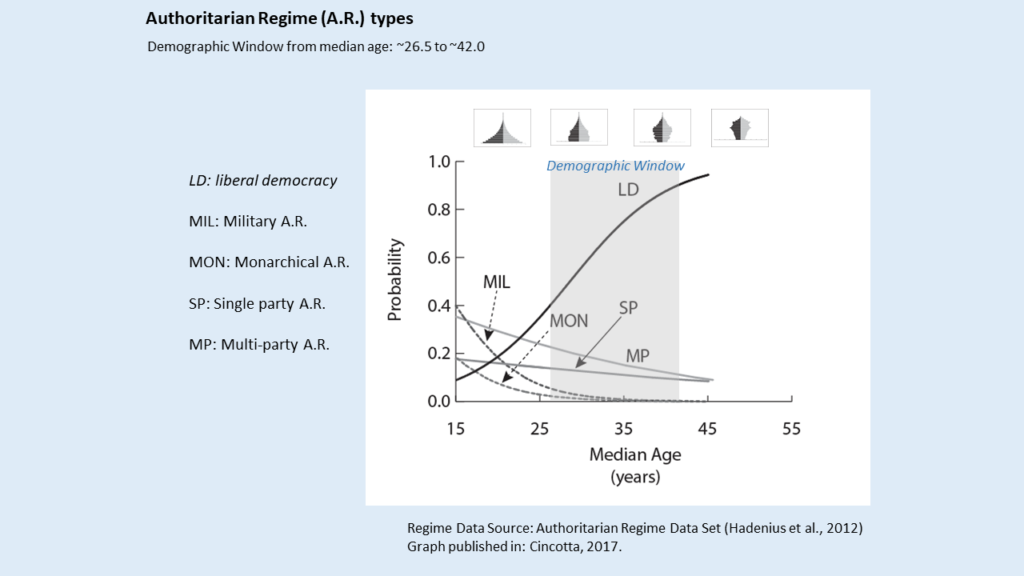 “Global Political Demography” in progress [Sept. 2018]. Editors Achim Goerres (U. Duisburg-Essen) and Pieter Vanhuyesse (U. Southern Denmark) are currently managing the review and editing processes of Global Political Demography, which is scheduled to be published in 2019. The initial meeting of authors was held in November 2017, at the Käte Hamburger Kolleg/Center for Global Cooperation Research at the University of Duisburg-Essen, Germany. My contribution to this book is entitled, “Youthful Age Structures and the Risks of Revolutionary and Separatist Conflicts” (author: Richard Cincotta).
“Global Political Demography” in progress [Sept. 2018]. Editors Achim Goerres (U. Duisburg-Essen) and Pieter Vanhuyesse (U. Southern Denmark) are currently managing the review and editing processes of Global Political Demography, which is scheduled to be published in 2019. The initial meeting of authors was held in November 2017, at the Käte Hamburger Kolleg/Center for Global Cooperation Research at the University of Duisburg-Essen, Germany. My contribution to this book is entitled, “Youthful Age Structures and the Risks of Revolutionary and Separatist Conflicts” (author: Richard Cincotta).
Topic: News
Demography: A Development Perspective
Security and Development in Global Politics: A Critical Comparison
Joanna Spear & Paul Williams, eds., Georgetown U. Press, 2012.
This excellent collection of articles on development and security has found its way into university classrooms. It contains two articles on politics, development, and demography that (I think) are essential reading for those interested in economic and political demography (the second article is downloadable from this website):
Goldstone, J. 2012. “Demography: A Security Perspective.” Pp. 271-289 in Security and Development in Global Politics: A Critical Comparison, edited by J. Spear and P.D. Williams. Washington, DC: Georgetown University Press.
Cincotta, R.P. 2012. “Demography: A Development Perspective.” Pp. 291-310 in Security and Development in Global Politics: A Critical Comparison, edited by J. Spear and P.D. Williams. Washington, DC: Georgetown University Press. [Download this extensive review of research on Demography and Development here]
Attachments
Demography Podcast: Everybody Counts
Everybody Counts (by Jennifer Sciubba) is a podcast about all the ways human population shapes our world. From mass urbanization to massive refugee flows, high fertility to record low birth rates, population trends have social, political, and economic consequences. The world’s population is changing in unprecedented ways, and this podcast helps listeners make sense of those changes. Listen (& subscribe) to Jennifer Sciubba’s (professor, Rhodes College) podcast at this site: Everybody Counts.
Attachments
The 4 Dividends: PRB’s Pace Project
 See the Population Reference Bureau’s excellent video explaining the “Four Dividends” that countries generally attain following fertility decline as they pass through the demographic window. These four dividends are: (1) child survival, (2) educational attainment, (3) per-capita income, and (4) political stability (measured by 10-year risk of intra-state conflict).
See the Population Reference Bureau’s excellent video explaining the “Four Dividends” that countries generally attain following fertility decline as they pass through the demographic window. These four dividends are: (1) child survival, (2) educational attainment, (3) per-capita income, and (4) political stability (measured by 10-year risk of intra-state conflict).
Here are links to obtain the IUSSP Conference paper (authored by Elizabeth Madsen and me) that describes the timing of these changes, in terms of the movement of countries through the age-structural transition. A background paper on the Age-structural Theory of State Behavior is published in the Oxford Research Encyclopedia of Politics. Some of this information is published in a short essay on the “Eight Rules of Political Demography“, on the New Security Beat.
Attachments
Article by Leonid Bershidsky in Bloomberg View
“Democracy in Iran? The demographics say YES” — but the Regime Type says NO
Bloomberg View (plus Bloomberg Business Week) has published Leonid Bershidsky’s excellent article on age-structural theory. Clearly, Bershidsky has read through and grasped much of the research (thank you, Leonid!). Bershidsky uses the theory to discuss recent anti-regime demonstrations in Iran and their outcome, and he neatly summarizes the theory’s predictions and points out its strengths. Notably, he also explores some of the theory’s weaknesses dealing with various types of authoritarian regimes that persist despite the societal changes that are associated with a more mature population and passage through the demographic window.
The article can be viewed at the Bloomberg View website, here.
Bershidsky is right — that aspect of the theory remains weak. To strengthen it, I’ve been using the Authoritarian Regime Data Set (Hadenius, A., J. Teorell, and M. Wahman. 2012. “Authoritarian Regimes Data Set, version 5.0: Codebook.” Lund, Sweden: Department of Political Science, Lund University). Putting Hadenius et al.’s regime types into “age-structural time” produces the following hypothetical relationships with population age structure (click on image to enlarge it).


